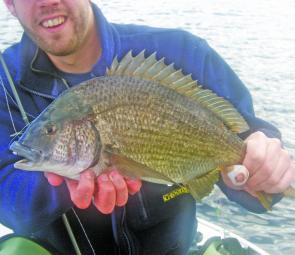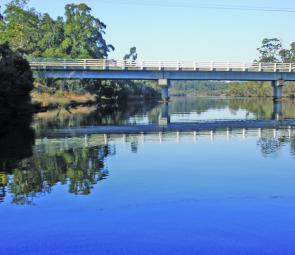Blessed with the promise of fine weather and warmer water temperatures the southern Tasmanian angler has a great deal to look forward too.
The estuary sports fishing has already begun to hot up with Australian salmon, flathead, mullet, mackerel and sea run trout all on offer.
The sea run trout are well and truly on the move with hopes of a bumper month or two to come; let’s just hope we don’t receive anymore snow in the coming weeks.
Although I heave heard very little from the west coast rivers I am also sure the locals are getting geared up for November when the whitebait/sea run trout turn up in the largest numbers.
The blue water angler is as always catered for and although the colder water temperatures means there is no game fishing to speak of, the deep sea bottom fishing can be well and truly worthwhile. Striped trumpeter, morwong perch, and king flathead are all on the menu!
All these southern estuary systems and rivers can be frustrating fisheries but nevertheless they produce the goods the majority of times.
The next two months offer very good fishing with an array of species on offer. Two of the most sought after species are bream and sea trout, both of which provide exceptional sport.
For the ease of covering plenty of water, a boat is recommended but nevertheless land-based fishing is very worthwhile.
For those that prefer to bait fish the lower reaches of these rivers are alive with an array of species. Armed with a berley mix and live bait the fish will soon come to you, I promise!
The Esperance in particular offers some brilliant bait fishing with the oyster clad shores and deep holes offering perfect cover for both the above species plus an array of others.
I would recommend anglers use 6’6” through to 7’6” rods with a fast action; these should be rigged with suitably sized spinning reels spooled with 4-8lb line (mono being preferred).
Quill floats and running sinker rigs are effective although I would recommend anglers simply float baits casting and retrieving regularly.
Recommended baits are live yabbies, sandworms, prawns, fish flesh and pretty fish.
There might even be the odd garfish still available where a bread dough bait is recommended.
Fly anglers chasing the often ellusive sea run trout will do best to fish the Huon and Lune rivers with whitebait patterns such as the BMS being proven patterns. I choose to use two flies in tandem but this is up to the individual.
A floating or intermediate line rigged with a 6lb leader is usually sufficient. Other effective patterns are the Tasman Whitebait, Bushy’s Horror, Cutthroat Whitebait and Grey Ghost.
Lure anglers will catch an array of species on bibbed minnow and soft plastics; natural coloured lures that imitate pretty fish being the preferred choice.
Don’t forget to pack the standard silver wonder wobblers or gold 7g Toby as these are a favourite with the Atlantic salmon.
Anglers should keep in mind an inland fishing license is required when fishing the freshwater reaches of these systems. For more information contact the Inland Fisheries Service.
This location is a well known ‘hot spot’ for the southern Tasmanian angler it offering a variety of species.
The Hippolyte Rock, Sisters and Tasman Island are popular locations attracting large barracouta, and an array of bottom fish such as perch, striped trumpeter and gurnard.
Although October can be quite a windy month the odd still day offers superb bottom bouncing for the above mentioned species plus the odd flathead, and gummy shark.
All of these species are targeted by bottom fishing with a variety of rigs the most common of these being the traditional paternoster rig.
Although few and far between in modern times, the king flathead remains one of the most sought after deepwater species, being popular for both their sporting and table qualities.
Anglers should be prepared to fish numerous reefs in order to find numbers of these fish and once locating a patch of fish I would recommend anglers mark the location on the sounder. November and December are when the fishing peaks.
Unlike the common sand flathead, fresh bait and quality soft plastics are essential if to have success with this often difficult to catch species.
For those with smaller craft whom are unable to get out wide the inshore reefs hold good numbers of leatherjacket, wrasse and cod.
Fortescue Bay is often a welcome haven.
Reads: 2748
Bream are often found amongst the sea run trout.

The Lune River is a top spot for very big bream and good quality sea run trout.




